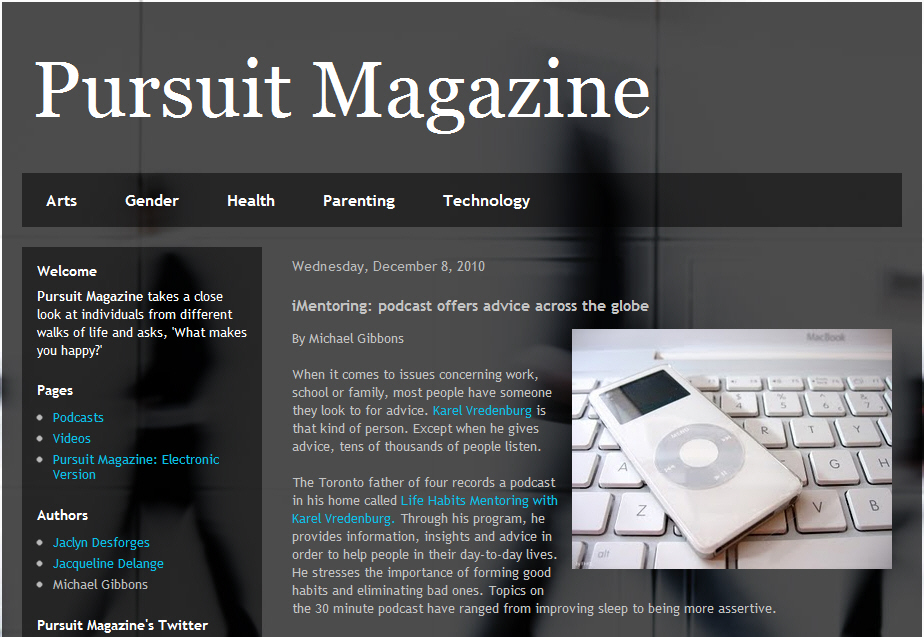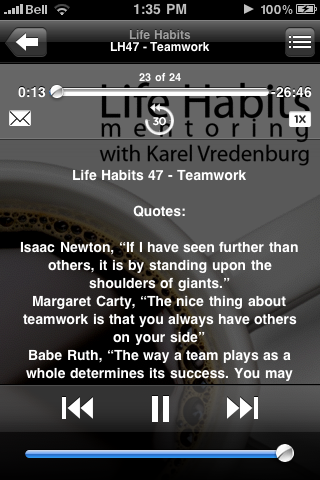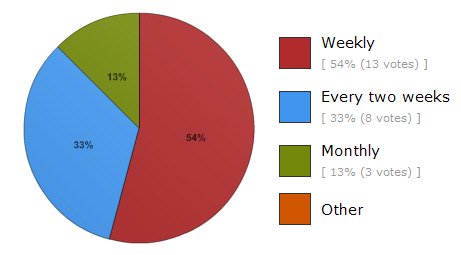Top 10 Life Habits Podcast Episodes
I've been reflecting on all the top ten this and top ten that I've seen on blogs and the social networks toward the end of the year. That got me thinking about what the top ten Life Habits podcast episodes would be. I had a look and aggregated the results from several of the top countries and found some pretty interesting results. They reflect the top ten episodes being listened to right now. The list may also be interesting to you if you haven't listened to the full 67 episodes produced to date and would like to listen to ones that other listeners are particularly interested in. This list may also be of interest to people who just got a device for Christmas and want to get into podcast listening too.
So, here's the list (the numbers in parentheses indicate the episode number):
- Types of Help (LH67)
- Assertiveness (LH49)
- Managing Stress (LH24)
- Visualizing Progress (LH64)
- 5 Lazy Ways to Get in Shape (LH66)
- Life Lessons (LH65)
- Stop Procrastinating (LH46)
- Time Management (LH2)
- Staying Positive (LH3)
- The Power of the Mind (LH4)
Many podcasts that deal with news or technology developments are time sensitive and listeners typically only listen to the most recent episode and past episodes have very little value because they're essentially old news. In contrast, my Life Habits episodes are essentially timeless and people regularly listen to the full list of epsides. Many listeners subscribe and listen to every episode as it comes out but others selectly listen to podcast topics that specifically interest them.
The most listened to episode right now is the most recent one that I did with UK Psychologist Mandy Kloppers.  In addition to being the most recent, it is a topic that I would think would be of particular interest to many of the listeners and Mandy also does a really good job of outlining the types of situations and challenges that would be appropriate for which to seek some professional help, the types of help that are available, and also what to expect and how to get the most out of the various types of professional help. Many people also have difficulty being appropriately assertive so that comes in as the second more popular episode. The session provides information on how to avoid being to unassertive but also very importantly to avoid being too aggressive too. We live in a rather stressful world so managing stress comes in at position three. Visualization of your goals and visualizing progress toward them is important and the episode on that topic came in at position four. The session with my regular guest Marie-Josée Shar on five lazy ways to get into shape is especially of interest at the moment when many people have resolved to get into better shape so this episode came in at position five. Steve Jobs's life lessons came in at the sixth position. The common challenges of procrastination, time management, and staying positive took positions seven, eight, and nine. The tenth slot was taken by my session on the power of the mind during which I describe the various biases we have and often don't know we have. If you'd like to check out these episodes, you can do so by going to the podcast page on iTunes or the show notes site.
In addition to being the most recent, it is a topic that I would think would be of particular interest to many of the listeners and Mandy also does a really good job of outlining the types of situations and challenges that would be appropriate for which to seek some professional help, the types of help that are available, and also what to expect and how to get the most out of the various types of professional help. Many people also have difficulty being appropriately assertive so that comes in as the second more popular episode. The session provides information on how to avoid being to unassertive but also very importantly to avoid being too aggressive too. We live in a rather stressful world so managing stress comes in at position three. Visualization of your goals and visualizing progress toward them is important and the episode on that topic came in at position four. The session with my regular guest Marie-Josée Shar on five lazy ways to get into shape is especially of interest at the moment when many people have resolved to get into better shape so this episode came in at position five. Steve Jobs's life lessons came in at the sixth position. The common challenges of procrastination, time management, and staying positive took positions seven, eight, and nine. The tenth slot was taken by my session on the power of the mind during which I describe the various biases we have and often don't know we have. If you'd like to check out these episodes, you can do so by going to the podcast page on iTunes or the show notes site.
Back from the Life Habits Hiatus
Life sometimes gets busy. Mine got a lot busier than my normal busy over the past while which also resulted in an unplanned hiatus from my Life Habits podcast series. The podcast is my hobby and a particularly enjoyable passion of mine. However, when things get busy, our hobbies get squeezed and this one of mine did.
A staycation during the US Thanksgiving break allowed me to get caught up. I recorded an episode titled Life Lessons which was a companion to the previous blog post on this site about Steve Jobs. The blog post focused specifically on Steve's contributions to design while the podcast episode dealt more broadly with the advice and lessons we can glean from Steve's life.
I also just completed an interview episode titled "5 Lazy Ways to Get in Shape" with Marie-Josée Shaar.  She and Kathryn Britton recently published a great new book "Smarts and Stamina: The Busy Person's Guide to Optimal Health and Performance". My intereview with Marie-Josée covers a subset of the material in the book and includes advice to sleep all you need, to eat by design, to "do a mini", to not make it a big production, and to exercise on company time. I love how practical the advice is that she shares, the way she explains foundational concepts, the examples she provides, how she practices what she preaches, and how she clearly is living proof of the efficacy of the approach. Marie-Josée also knows of what she speaks in that she has a degree in Organizational Behavior from McGill University, a Master of Applied Psychology from University of Pennsylvania, and she's also certified as a Personal Trainer and is a Certified Nutrition and Wellness Consultant.
She and Kathryn Britton recently published a great new book "Smarts and Stamina: The Busy Person's Guide to Optimal Health and Performance". My intereview with Marie-Josée covers a subset of the material in the book and includes advice to sleep all you need, to eat by design, to "do a mini", to not make it a big production, and to exercise on company time. I love how practical the advice is that she shares, the way she explains foundational concepts, the examples she provides, how she practices what she preaches, and how she clearly is living proof of the efficacy of the approach. Marie-Josée also knows of what she speaks in that she has a degree in Organizational Behavior from McGill University, a Master of Applied Psychology from University of Pennsylvania, and she's also certified as a Personal Trainer and is a Certified Nutrition and Wellness Consultant.
I encourage you to check out these new episodes and let me know what you think.
Keep Old Media Out of New Media
I enjoy listening to and creating podcasts. To me they represent what is truly unique and good about new media. I was therefore taken aback when I was listening to one of my favorite podcasts, Stuff You Should Know, and heard the hosts read a letter from a listener by the name of Katie. This listener was from old media and criticized everything I believe is special about the new media as exemplified by Josh and Chuck's very successful podcast series. She thought the podcast should be more polished, more thoroughly edited, and could do without the delightful exchanges between the two hosts. The essence of her argument was that the podcast should conform to the style, format, and content of old media. While I'm sure she meant well, I couldn't disagree more with her arguments. And it got me thinking about a trend that I'm seeing with new media as it is increasingly taken over by old media.
good about new media. I was therefore taken aback when I was listening to one of my favorite podcasts, Stuff You Should Know, and heard the hosts read a letter from a listener by the name of Katie. This listener was from old media and criticized everything I believe is special about the new media as exemplified by Josh and Chuck's very successful podcast series. She thought the podcast should be more polished, more thoroughly edited, and could do without the delightful exchanges between the two hosts. The essence of her argument was that the podcast should conform to the style, format, and content of old media. While I'm sure she meant well, I couldn't disagree more with her arguments. And it got me thinking about a trend that I'm seeing with new media as it is increasingly taken over by old media.
Right after I listened to that episode of Stuff You Should Know, I finished listening to Tim Wu's book "The Master Switch: The Rise and Fall of Information Empires". I would recommend that anyone interested in the history of information empires and an insightful analysis of the trends, read Tim's book. The book points out that previous information innovations cycled between decentralization and centralization. The internet and new media in general, according to the author, has thus far not repeated the trend evidenced during previous introductions of new information technologies. However, I think we're starting to see wonderful decentralized web and new media attempting to be taken over by old media and thus becoming more centralized. I was even approached by old media proposing to convert my Life Habits podcast series into a syndicated terrestrial radio program. Of course, the podcast would have had to change to conform to the old media format and style which in my view would have fundamentally changed it's essential character. When I mentioned this to friends, they were impressed that old media came calling. However, I find it strange that people still consider being asked to contribute to old media having "made it". To me, being successful with a piece of new media means having a lot of people actually download it, provide positive ratings on it, and having it rank highly on iTunes. I think it would be a shame if we all went back to the old media format and characteristics because it would mean losing what is truly special about new media (thanks to Pete Price for the above photo via Creative Commons).
Life Habits is on Facebook
Listeners of my Life Habits podcast have requested that I create a Facebook page for the series. Thus far, I've just had listeners join my personal Facebook page. However, given the interest and the opportunity to use the space to provide updates, photos, and behind-the-scenes information, I've now created a dedicated Facebook page. If you listen to the podcast, please visit the Life Habits podcast page on Facebook and click the "Like" button. I look forward to interacting with you over on the page. Thanks!
I've just had listeners join my personal Facebook page. However, given the interest and the opportunity to use the space to provide updates, photos, and behind-the-scenes information, I've now created a dedicated Facebook page. If you listen to the podcast, please visit the Life Habits podcast page on Facebook and click the "Like" button. I look forward to interacting with you over on the page. Thanks!
Getting Healthy
I've been thinking lately about the importance of being healthy. The impact on longevity, quality of life, and even the planet. The feedback I've been getting on my Life Habits podcast reinforces that a lot of other people are thinking about their health and improving it too. I had created podcast episodes some time ago on health topics but decided in response to listener questions to put together a few deeper sessions on the topic. I did a session with Marie-Josee Shaar on Sleep, Mood, Food, and Exercise (iTunes, website), and a further drill-down on Sleep (iTunes, website) and other on Exercise (iTunes, website) with Marie-Josee. I recorded a self-guided audio instruction session on progressive muscle relaxation (iTunes, website) and recently published an episode on adopting a plant-based diet and lifestyle with Dilip Barman (iTunes, website). I'd also like to recommend some iPhone apps that are particularly good at promoting health including MyFitnessPal (iTunes) and Get Running (iTunes). As John F Kennedy said, “Physical fitness is not only one of the most important keys to a healthy body, it is the basis of dynamic and creative intellectual activity.” And as Julius Erving rightly pointed out, "If you don't do what's best for your body, you're the one who comes up on the short end."
Habits podcast reinforces that a lot of other people are thinking about their health and improving it too. I had created podcast episodes some time ago on health topics but decided in response to listener questions to put together a few deeper sessions on the topic. I did a session with Marie-Josee Shaar on Sleep, Mood, Food, and Exercise (iTunes, website), and a further drill-down on Sleep (iTunes, website) and other on Exercise (iTunes, website) with Marie-Josee. I recorded a self-guided audio instruction session on progressive muscle relaxation (iTunes, website) and recently published an episode on adopting a plant-based diet and lifestyle with Dilip Barman (iTunes, website). I'd also like to recommend some iPhone apps that are particularly good at promoting health including MyFitnessPal (iTunes) and Get Running (iTunes). As John F Kennedy said, “Physical fitness is not only one of the most important keys to a healthy body, it is the basis of dynamic and creative intellectual activity.” And as Julius Erving rightly pointed out, "If you don't do what's best for your body, you're the one who comes up on the short end."
What's Interesting to Different Cultures?
My Life Habits podcast series is often included in the top 10 list of most popular podcasts in the self-help category on iTunes. I'm so gratified and humbled when I see those numbers. I don't check them all that often largely because it is actually quite difficult to do but what is most interesting to me is how the popularity differs by country. As you probably know, the iTunes store is organized by country. As a result, all rankings, ratings, and comments are shown separately per country. The podcast as a whole is typically popular in Canada, the US, the UK, and Australia. Interestingly, it is also popular in countries like India, the Dominican Republic, South Africa, and Singapore. The iTunes ranking algorithm appears to run constantly and results are updated several times per day. When I've periodically looked at this, it seemed to me that the popularity ranking differred per country depending on the latest podcast episode topic.
To determine whether certain topics are of greater or lesser interest to certain countries, I had a look at one of the tables that are presented in iTunes which shows the most popular episodes in that country. Here are the results for Canada, the US, and India.
 Canada
Canada
 United States
United States
 India
India
You've probably noticed that the results are heavily weighted toward podcast episodes that have been out the longest as they've had the greatest opportunity to be downloaded. However, the differences in the topics are nonetheless interesting to examine.
I find it interesting that Canada, a country of relatively recent immigrants, finds the "dealing with a flat world" the most interesting. That episode addressed approaches to effectively and sensitively dealing with colleagues and friends of diverse cultures worldwide. Canadians are also interested in practical topics like stopping procrastination and developing effective public speaking skills, exploring sex differences, as well as broadening topics like self-actualization.
Time management is of greatest interest to Americans indicating perhaps that the challenges of balancing multiple priorities with time pressures are of particular concern to them. US listeners are also particularly interested in keeping a positive perspective on life, simplifying life, learning about becoming fit for the long term, and finding out about the various ways our mind has power over us and how we can control that power.
Effective public speaking is of greatest interest to listeners in India, a topic that was of some interest to Canadians as well. Indian listeners also shared an interest in sex differences with Canadian listeners and the topic of fitness with American listeners. Listeners in India had a unique interest in fostering creativity and further developing their capacity for forgiveness and compassion.
I find these cultural differences fascinating as I do the realization that people all over the globe actually listen to what I have to say. That's so cool! These findings also make me wonder whether there are certain topics that I haven't addressed on the podcast that may be of special interest to particular countries. If you have any such topics, please send me an email at lifehabits@gmail.com.
iMentoring: Technology-Enabled Self-Improvement
I was interviewed recently for an article in Pursuit Magazine about my Life Habits podcast series. That piece and a comment from a listener that I read in the Australian iTunes store got me thinking about the changes taking place in the ways in which people can go about improving themselves. In the not so distant past, the options you had for getting help for improving yourself were limited to finding and then visiting with a personal life coach or mentor (often a Psychologist in private practice), buying a book on a subject that you wanted to improve upon, or sending for CDs or audio tapes that you learned about from ads in magazines or on television. While these types of self-improvement still exist and can be quite useful, people aren't limited to only these for-fee options. People can now use their Smartphone or iPod type portable audio player to find and play thousands of podcasts on a wide variety of self-improvement topics. Listener Toni in Australia points out a key benefit of podcasts like mine, "...you get the feeling that he is your own personal coach/mentor." Despite using a fairly impersonal communication mechanism, listening to podcasts particularly when using headphones can often give the listener an intimate connection to the person on the podcast which has the effect of reinforcing the messages being given and making them more personal. In addition, the podcasts are free, come out with a new episode on a regular basis, and the best of them encourage two-way communication and a feeling of community.
and a comment from a listener that I read in the Australian iTunes store got me thinking about the changes taking place in the ways in which people can go about improving themselves. In the not so distant past, the options you had for getting help for improving yourself were limited to finding and then visiting with a personal life coach or mentor (often a Psychologist in private practice), buying a book on a subject that you wanted to improve upon, or sending for CDs or audio tapes that you learned about from ads in magazines or on television. While these types of self-improvement still exist and can be quite useful, people aren't limited to only these for-fee options. People can now use their Smartphone or iPod type portable audio player to find and play thousands of podcasts on a wide variety of self-improvement topics. Listener Toni in Australia points out a key benefit of podcasts like mine, "...you get the feeling that he is your own personal coach/mentor." Despite using a fairly impersonal communication mechanism, listening to podcasts particularly when using headphones can often give the listener an intimate connection to the person on the podcast which has the effect of reinforcing the messages being given and making them more personal. In addition, the podcasts are free, come out with a new episode on a regular basis, and the best of them encourage two-way communication and a feeling of community.
A lot of people can be helped world-wide using podcasts. My own is popular in the major English speaking countries like the US, Canada, Australia, and the UK but increasingly it is also on the top 10 list of podcasts in countries like India and Singapore. Electronic delivery of mp3 files via iTunes makes all of this possible. It is quite phenomenal the increase in reach that these technologies afford and, in turn, the ability to have huge populations of listeners glean the benefits of these programs.
Of course, not all improvement can be self-improvement.  Mandy KloppersCertain problems still require one-on-one attention from a professional. In the case of my podcast, I only provide the podcast material myself but I regularly invite guests to join me on particular episodes to address topics on which they are experts. Those guests thus far have been professionals who also provide individual counselling in their offices as well as technology-mediated sessions. UK Psychologist Mandy Kloppers does it all. She runs Mandy Jane - Life Design and has consulting rooms in Woking, Surrey, UK, but also provides counseling by phone, email, text, and Skype. She specializes in personal relationships, depression, anxiety, and self-improvement/personal development. US-based Marie-Josée Shaar runs Smarts and Stamina which is dedicated to providing "accessible, high-quality, scientifically-based healthy mind, body, and productivity information" to help "cultivate
Mandy KloppersCertain problems still require one-on-one attention from a professional. In the case of my podcast, I only provide the podcast material myself but I regularly invite guests to join me on particular episodes to address topics on which they are experts. Those guests thus far have been professionals who also provide individual counselling in their offices as well as technology-mediated sessions. UK Psychologist Mandy Kloppers does it all. She runs Mandy Jane - Life Design and has consulting rooms in Woking, Surrey, UK, but also provides counseling by phone, email, text, and Skype. She specializes in personal relationships, depression, anxiety, and self-improvement/personal development. US-based Marie-Josée Shaar runs Smarts and Stamina which is dedicated to providing "accessible, high-quality, scientifically-based healthy mind, body, and productivity information" to help "cultivate Marie-Josée Shaar a positive work environment that promotes productivity, engagement, and innovation" by empowering clients "to make their best, most significant contributions everyday at work, at home, and in the world". Marie-Josée provides training to companies, counseling to individuals. and writes a great short newsletter.
Marie-Josée Shaar a positive work environment that promotes productivity, engagement, and innovation" by empowering clients "to make their best, most significant contributions everyday at work, at home, and in the world". Marie-Josée provides training to companies, counseling to individuals. and writes a great short newsletter. 
To participate in this iMentoring experience you simply need to subscribe to the Life Habits podcast within iTunes or go to the shownotes site. Recent episodes have included ones on taking things too personally and improving sleep. The latter episode was with Marie-Josée, and new episodes with Mandy and with Kathryn will be recorded very soon. Of course, don't limit yourself to my Life Habits podcast series, I'd suggest you check out the other fine self-improvement podcasts that are available as well and enjoy iMentoring.
Effective Management
A listener to my Life Habits podcast series asked me to address the topic of effective management in a podcast episode. I've been a manager for close to two decades and have recently been promoted to an executive management position. That got me thinking about what I consider to be the key ingredients to being an effective manager. I also realized that most of the ingredients are the same whether someone holds a formal position of manager or serves in a management like role (including parents, coaches, etc.). I had already devoted a previous episode to the topic of leadership, which I believe is closely related. Someone can be a manager without being a leader and a leader without being a manager but I believe both sets of skills are most effective together. I compiled some interesting quotes, put together a top 10 list (actually counted wrong and the list actually has 11 items in it), and recorded the podcast episode. You can access it within iTunes or via the show notes site. I'd appreciate any thought you may want to share after you listen to the podcast episode.
executive management position. That got me thinking about what I consider to be the key ingredients to being an effective manager. I also realized that most of the ingredients are the same whether someone holds a formal position of manager or serves in a management like role (including parents, coaches, etc.). I had already devoted a previous episode to the topic of leadership, which I believe is closely related. Someone can be a manager without being a leader and a leader without being a manager but I believe both sets of skills are most effective together. I compiled some interesting quotes, put together a top 10 list (actually counted wrong and the list actually has 11 items in it), and recorded the podcast episode. You can access it within iTunes or via the show notes site. I'd appreciate any thought you may want to share after you listen to the podcast episode.
Communicating Assertively
I do a podcast series called Life Habits Mentoring, as most of you probably know. I just recorded an episode on the topic of communicating assertively. I've always believed that interpersonal communication is critically important in all aspects of life, whether communicating the features of a design you've just done, discussing a problem with a family member, or expressing your views to a good friend.  I provide advice on how to achieve balance in your communication between being passive and not expressing your your views at all to being too aggressive and expressing your views at the expense of other people. I don't pretend that I'm perfect at this myself but I think the top 10 items I've compiled will make anyone more assertive and, in turn, more effective in life. You can listen to the podcast episode on my Life Habits show notes website or via iTunes.
I provide advice on how to achieve balance in your communication between being passive and not expressing your your views at all to being too aggressive and expressing your views at the expense of other people. I don't pretend that I'm perfect at this myself but I think the top 10 items I've compiled will make anyone more assertive and, in turn, more effective in life. You can listen to the podcast episode on my Life Habits show notes website or via iTunes.
Length of Podcast Episodes
I ask for feedback on my podcasts on a regular basis in order to further improve them. One recurring theme
Optimizing Teamwork
Most of what we do at work and at play is done with other people. However, little attention is often paid to enhancing what we do with others in teams. There is certainly lots of attention on how to improve the performance of sports teams but that isn't the case for other teams in work and educational settings. A listener of my Life Habits podcast series sent me a question on this topic. She used to be an Olympic athlete in a non-team sport and was now retired from sports and needing to learn how to work effectively and optimally on teams at work. I gave that some thought and came up with a list of ten ideas to consider in enhancing and optimizing the workings of teams. I recorded a podcast episode on the topic which you can listen to via the Life Habits iTunes page or via the web at the Life Habits show notes site. I would appreciate any thoughts you may have on the episode and the ideas discussed in it. (the photograph on the right is courtesy of Ingorrr via Creative Commons license)
of sports teams but that isn't the case for other teams in work and educational settings. A listener of my Life Habits podcast series sent me a question on this topic. She used to be an Olympic athlete in a non-team sport and was now retired from sports and needing to learn how to work effectively and optimally on teams at work. I gave that some thought and came up with a list of ten ideas to consider in enhancing and optimizing the workings of teams. I recorded a podcast episode on the topic which you can listen to via the Life Habits iTunes page or via the web at the Life Habits show notes site. I would appreciate any thoughts you may have on the episode and the ideas discussed in it. (the photograph on the right is courtesy of Ingorrr via Creative Commons license)
Is Web Media Ready for Prime Time?
I've been listening to podcasts for years and currently subscribe to a total of 32 podcast series. As you know, I also create two podcasts myself. I think that I'm hooked on this type of media. As most people do, I prefer my podcasts in audio format because I'm usually doing something else with my eyes while listening to podcasts like driving, running, or doing the dishes. I still subscribe to video podcasts but mostly listen to the audio track only. I occasionally find that I need to turn on my iPhone to view the video when video is critical to the subject matter. This usually happens on TED.com Talks and sometimes on GeekBrief.TV. I listen to practically all of the podcasts on Leo Laporte's This Week in Tech (TWIT) podcast network but rarely even feel the need to watch the video. I occasionally turn on the video to see what a new guest looks like but that's about it. Leo is a real pioneer and tends to push the technology envelop and is usually successful with it. He's one of only a few professional podcasters making good money in the field. His latest push is into streaming video and making video podcasts and YouTube replays available. Others that have done this have adopted the a studio model and while still relatively informal, still making the video content look professional. Leo, on the other hand, makes video available but up until the last week hasn't paid any attention to the professionalism of the video stream content. Shown in the picture here is a regular guest on the flagship TWIT show. Having a massive microphone dangling right in front of the guest's face isn't perhaps the best way to produce web-based video content. Leo and his other guests also usually wear large headphones. So, my vote thus far is that although it is technically possible to create video content on the web, those producing it aren't quite ready for prime time. The last episode of the TWIT show did include a discussion of smaller microphones but there wasn't any mention of not having them cover the guest's face nor any discussion of getting rid of the headphones in favor of the discrete ear buds used on TV which I also use when I use video conferencing at work. I should point out that there are video podcasts that have good production values and, thus, are ready for prime time. However, the most popular tech podcast network doesn't yet appear to be.
know, I also create two podcasts myself. I think that I'm hooked on this type of media. As most people do, I prefer my podcasts in audio format because I'm usually doing something else with my eyes while listening to podcasts like driving, running, or doing the dishes. I still subscribe to video podcasts but mostly listen to the audio track only. I occasionally find that I need to turn on my iPhone to view the video when video is critical to the subject matter. This usually happens on TED.com Talks and sometimes on GeekBrief.TV. I listen to practically all of the podcasts on Leo Laporte's This Week in Tech (TWIT) podcast network but rarely even feel the need to watch the video. I occasionally turn on the video to see what a new guest looks like but that's about it. Leo is a real pioneer and tends to push the technology envelop and is usually successful with it. He's one of only a few professional podcasters making good money in the field. His latest push is into streaming video and making video podcasts and YouTube replays available. Others that have done this have adopted the a studio model and while still relatively informal, still making the video content look professional. Leo, on the other hand, makes video available but up until the last week hasn't paid any attention to the professionalism of the video stream content. Shown in the picture here is a regular guest on the flagship TWIT show. Having a massive microphone dangling right in front of the guest's face isn't perhaps the best way to produce web-based video content. Leo and his other guests also usually wear large headphones. So, my vote thus far is that although it is technically possible to create video content on the web, those producing it aren't quite ready for prime time. The last episode of the TWIT show did include a discussion of smaller microphones but there wasn't any mention of not having them cover the guest's face nor any discussion of getting rid of the headphones in favor of the discrete ear buds used on TV which I also use when I use video conferencing at work. I should point out that there are video podcasts that have good production values and, thus, are ready for prime time. However, the most popular tech podcast network doesn't yet appear to be.
Frequency of Podcasts
I've been a podcaster for more than two years now, producing the UXDesignCast and Life Habits podcast series. I've often wondered at what frequency listeners would like to have the podcast delivered. My ideal frequency, and the frequency I like to receive the podcasts I listen to, is weekly. I listen to a lot of podcasts in a week and typically get through them all in the week. I get a fair bit of feedback from listeners, especially from those who listen to the Life Habits series. Of the feedback that concerns the frequency of episodes, listeners who write in generally ask for more frequent delivery of them. Of course, it could be the case that the people who write in are into the podcast the most and, as a result, want more episodes faster. Podcast download statistics aren't really much use in this regard because subscribers have the episodes delivered to them automatically as soon as they become available and it isn't possible to know when they actually listened to the episodes that were downloaded. I therefore decided to put up a quick poll to ask the question, "How frequently would you like to have podcast episodes made available?" with the response alternatives of "weekly", "every two weeks", "monthly", and "other". The results indicate that 54% of respondents prefer weekly episodes, 33% every two weeks, and 13% monthly. So, the vast majority of 87% would like to have episodes within a two week period and the majority of those prefer them to appear weekly. This tells me that I should continue to try to deliver on a weekly basis but, if circumstances prevent that and an episode comes out in two weeks, it will still satisfy most listeners. Of course, I do target putting out weekly episodes, particularly for my Life Habits podcast series. I'll continue to do that then and will try to increase the frequency of the UXDesignCast ones as well. Of course, feel free to provide any additional feedback you may have on this via the comment feature of this site.
therefore decided to put up a quick poll to ask the question, "How frequently would you like to have podcast episodes made available?" with the response alternatives of "weekly", "every two weeks", "monthly", and "other". The results indicate that 54% of respondents prefer weekly episodes, 33% every two weeks, and 13% monthly. So, the vast majority of 87% would like to have episodes within a two week period and the majority of those prefer them to appear weekly. This tells me that I should continue to try to deliver on a weekly basis but, if circumstances prevent that and an episode comes out in two weeks, it will still satisfy most listeners. Of course, I do target putting out weekly episodes, particularly for my Life Habits podcast series. I'll continue to do that then and will try to increase the frequency of the UXDesignCast ones as well. Of course, feel free to provide any additional feedback you may have on this via the comment feature of this site.
Getting Unstuck
We all experience it at some point - getting into a rut and not knowing how to get out of it. We may be working on a creative improvement in our careers, getting going with an exercise program, losing weight, increasing our expression of gratitude, improving our presentation skills, and so on. No matter what the focus of our desired improvement is, actually getting going on it is often really challenging. Of course, if it was easy, everyone would be doing it - and they're not typically. So how can you get yourself unstuck. I gave that some thought, found some inspirational quotes on the topic, put together a top 10 list of ideas, and put it all together in a Life Habits podcast episode. You can access it within iTunes, Zune, or at the show notes site. Of course, you can also listen to it right here on this website using the Life Habits player in the right column. Please note that the picture on the right is a good example of a reminder that is discussed on the podcast that can be used as inspiration and motivation in this case for starting a running program. The photograph is a Creative Commons Image courtesy of Thomas Hawk called "A Brand New Day".
increasing our expression of gratitude, improving our presentation skills, and so on. No matter what the focus of our desired improvement is, actually getting going on it is often really challenging. Of course, if it was easy, everyone would be doing it - and they're not typically. So how can you get yourself unstuck. I gave that some thought, found some inspirational quotes on the topic, put together a top 10 list of ideas, and put it all together in a Life Habits podcast episode. You can access it within iTunes, Zune, or at the show notes site. Of course, you can also listen to it right here on this website using the Life Habits player in the right column. Please note that the picture on the right is a good example of a reminder that is discussed on the podcast that can be used as inspiration and motivation in this case for starting a running program. The photograph is a Creative Commons Image courtesy of Thomas Hawk called "A Brand New Day".
Optimizing Body and Mind
I just completed an interview with Marie-Josee Salvas Shaar for my Life Habits podcast series. The topi c was sleep, food, mood, and exercise. It really got me thinking. Marie-Josee's theme throughout the session is that all four of these elements work together in an integrated fashion and working on each of them will yield a multiplicative overall effect. She has some great advice regarding what to eat in order to optimize creativity. She also stresses the importance of sleep and provides advice on getting good sleep. She describes ten recommendations each supported by research evidence. It is a worthwhile listen. You can get the episode on iTunes, Zune, or at my podcast show notes site. I'd appreciate any thoughts or comments you may have on it.
c was sleep, food, mood, and exercise. It really got me thinking. Marie-Josee's theme throughout the session is that all four of these elements work together in an integrated fashion and working on each of them will yield a multiplicative overall effect. She has some great advice regarding what to eat in order to optimize creativity. She also stresses the importance of sleep and provides advice on getting good sleep. She describes ten recommendations each supported by research evidence. It is a worthwhile listen. You can get the episode on iTunes, Zune, or at my podcast show notes site. I'd appreciate any thoughts or comments you may have on it.
Mobile Work
I've observed colleagues for years walking around with their Blackberries staying connected with their work. While I've stayed connected with work via cellphone and texting, I haven't until very recently used a smartphone to connect to work e-mail, intranet, and other work applications. I've just installed IBM Lotus Notes Traveler and I absolutely love it. I now have my work e-mail, calendar, contacts, to do lists all directly integrated seamlessly into the relevant apps and services on my iPhone. Through VPN on the iPhone, I also now have access to the company intranet and services like chat messaging.
I find it amazingly convenient to be able to quickly check my work e-mail while in line at the coffee shop and to look up where my first meeting of the day is when I'm running late and don't have time to take out and open up my notebook computer. It's an amazing time saver and uses the form factor I so love.
When I think about the convenience of having work information available like this on the device that's always in my podcast, I can imagine the utility of having it available on the somewhat larger but equally enjoyable iPad. I'm looking forward to that. There is one feature that I haven't heard anyone mention with regard to these devices that I think is critical for accessing work systems and that's fingerprint recognition. That would be so useful and Apple cool.
As always, I'd appreciate any thoughts you may have on my thoughts. By the way, I also wrote this post on my iPhone.
Social Software
We're all familiar with Social Software like Twitter, Facebook, YouTube, and blogs in the consumer space but little is often said about making this capability available in the enterprise space. I post regularly to all these systems and have done for some time but have been looking forward to a complete solution to use inside a company and behind its firewall as well. The latest release of our IBM Lotus Connections 2.5 product does just that. Listen to my interview with two of the lead designers on the project in this podcast.
Micro-blogging, Typography, Clouds, and Browsers
Joining me on this episode of UXDesignCast are Jay Trimble (Group Lead for the User Ce ntered Technology Group, NASA Ames Research Center), Keith Instone (Information Architecture Lead, IBM CIO’s Office, IBM.com), and Eliane Tozman (User Interface Designer, IBM Media Design Studio). The panel discusses the new way of using Web 2.0 including micro-blogging behind corporate firewalls with IBM Lotus Connections 2.5, the recent typography choices make by IKEA and what impact they may have, the need to consider the total cloud user experience importantly including ISPs, the implications for designers of Google’s Chrome Frame, key principles for and examples of effective Rich Internet Application (RIA) design, and planning for World Usability Day.
ntered Technology Group, NASA Ames Research Center), Keith Instone (Information Architecture Lead, IBM CIO’s Office, IBM.com), and Eliane Tozman (User Interface Designer, IBM Media Design Studio). The panel discusses the new way of using Web 2.0 including micro-blogging behind corporate firewalls with IBM Lotus Connections 2.5, the recent typography choices make by IKEA and what impact they may have, the need to consider the total cloud user experience importantly including ISPs, the implications for designers of Google’s Chrome Frame, key principles for and examples of effective Rich Internet Application (RIA) design, and planning for World Usability Day.
Producing a Podcast - Part II
I covered everything to think about, plan, and get in order to produce a podcast in Part I a number of blog posts ago. I'll cover the actual recording and post-production in this post. The recording setup is a little different for the case of recording a podcast with only me speaking versus the case when I have one or more guests. I use Audacity for the former and Pamela for the latter. Audacity is an amazing Open Source tool for recording and editing audio. It is also free. You can get it at SourceForge.net. Pamela is a call management tool for Skype which also does an amazing job of recording one or more Skype calls. Pamela isn't free but isn't very expensive.
 gauge. I also watch the visualization of the recording to ensure that levels don't get to high or too low. If I make a mistake, I simply leave a pause and then start again. I look for pauses during post-production in order to remove the sections with any errors.
gauge. I also watch the visualization of the recording to ensure that levels don't get to high or too low. If I make a mistake, I simply leave a pause and then start again. I look for pauses during post-production in order to remove the sections with any errors.- Install Skype if you don't already have it or if you already have it installed, make sure you have the latest version (via Help -> Latest Updates)
- Search for and connect with Skype userid "******" - that's the account that will call you on Skype just prior to the recording session
- Use a wired internet connection if possible although wireless will work if fast enough
- Make sure there are no other computers in the house (if you're recording from home) that are using the internet during the recording session
- Stop all resource intensive applications running on your computer
- Use a good quality headset and test it with the "Echo/Sound Test Service" in your Skype contacts list - (the computer mic is of insufficient quality)
- Make sure to participate on the podcast in a quiet setting with no background noise or distractions
- Please turn off all messaging clients (Sametime, MSN, etc.)
- Turn the ringer off on a phones and cell phones within earshot - even vibrate can be heard on the recording
- Keep a 3-6 inch distance of the microphone from your mouth and do not touch the microphone while we're recording
- If you need to adjust the microphone or headset during the call or cough, use the mute button on Skype, and remember to turn it off before talking
- Podcasts are quite informal so feel free to speak naturally in the way you would normally have a conversation with someone at a conference
- Make sure to sign-in to your Skype account a few minutes before the scheduled recording
I've tried to be detailed in my description but if any of this wasn't clear or you'd like to contribute your own experiences and recommendations, please feel free to use the commenting facility below to continue the discussion. Happy podcasting!
Social Networking: The Walled Garden
Like many of you, I'm on the major social networking systems Twitter and Facebook and also contribute content on this blog, two podcasts, and two websites. The problem I see is that each of these systems is a walled garden. Podcaster Leo Laporte has been talking about this in general lately too. When I write a post here, people read it and make comments on the blog itself. I also tweet about it on Twitter and send it as a link on Facebook. The latter two also often generate further discussion within Twitter and Facebook. The blog content is picked up by other sites and blogs which leads to further discussion there. The problem is that nothing pulls this all together. Readers of this blog don't see some of the great comments followers have tweeted on Twitter or friends have left on Facebook unless you follow me on Twitter or are a friend of mine on Facebook. Add to that, the comments regarding podcasts which are in iTunes and on the respective show notes sites.

